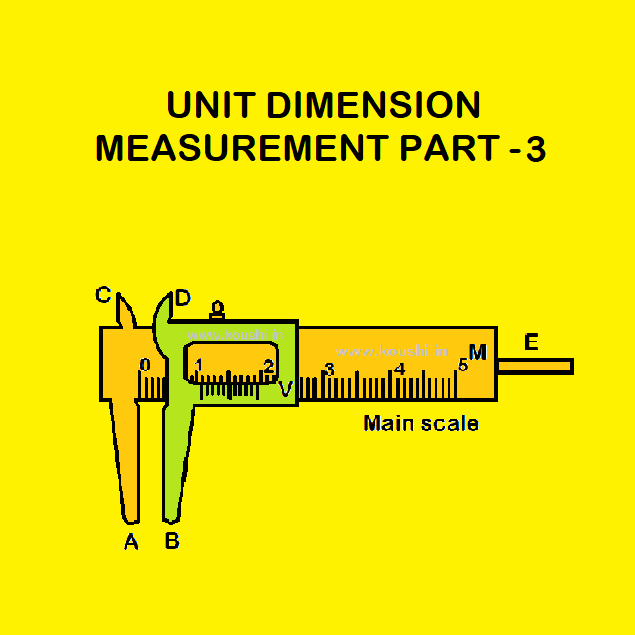Vernier calipers: Vernier calipers is used to measure length of a body. It consists of four parts.
(i) Main scale: It consists of a steel metallic strip (M) graduated in centimetre and millimetre in one edge and in inches in other edge.
(ii) Vernier scale. A vernier scale (V) slides on the strip M is graduated on both sides. The vernier scale which slides over the mm side has 10 divisions over a length of 9 division of main scale. Therefore, each division of vernier is 0.9mm.

(iii) Movable jaws: The Vernier scale carries movable jaws B and D projecting at right angle to the main scale. When B touches A, straight side of D will touch straight side of C. In this position, vernier zero coincide with zero of main scales and the vernier is error free.
(iv) Metallic strip: There is a metallic strip (E) connected back side of vernier. When jaws A and B are separated, E moves outwards. This strip E is used for measuring the depth of a vessel.
Principle: The division of main scale which is just left to the vernier zero indicates the main scale reading (let main scale reading is M). If x division of vernier coincide with any division of main scale then,
total reading = M + x V.C.
Vernier constant: V.C. = 1 main scale division – 1 vernier scale division
= 1 mm – 0.9 mm = 0.1 mm = 0.01cm.
For example, M = 5.2 cm and x = 3
So, total reading = 5.2 + 3 ![]() 0.01 = 5.23 cm.
0.01 = 5.23 cm.
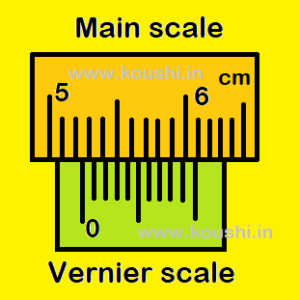
Zero error: If vernier zero does not coincide with zero of main scale when two jaws are connected then there is a zero error. Zero error may be positive or negative.
Zero error is positive if the zero of vernier scale lies to the right of the zero of main scale, when jaws A and B are in contact. The value of positive zero error is subtracted from the total reading.
For example, positive error = 8 ![]() 0.01 = 0.08 cm and the corrected reading = Total reading – error = 5.22 – 0.08 = 5.14 cm.
0.01 = 0.08 cm and the corrected reading = Total reading – error = 5.22 – 0.08 = 5.14 cm.
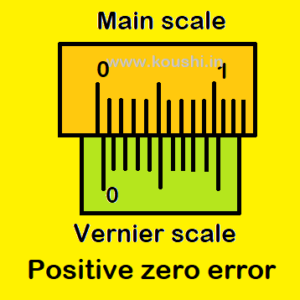
Zero error is negative if the zero of vernier scale lies to the left of the zero of main scale, when jaws A and B are in contact. The value of negative zero error is added with the total reading.
For example, negative error = – 8 ![]() 0.01 = 0.08 cm and the corrected reading = Total reading – error = 5.22 – (-0.08) = 5.22 + 0.08 = 5.30 cm.
0.01 = 0.08 cm and the corrected reading = Total reading – error = 5.22 – (-0.08) = 5.22 + 0.08 = 5.30 cm.

Screw gauge: Screw gauge is used to measure the diameter of a wire or rod. It consists of two scale one is linear and other is circular scale. Each division of linear scale is 1mm if circular scale consists of 100 divisions. If there are 50 divisions in circular scale then each division of linear scale is 0.5mm.
Pitch of the screw =
Least count of the screw = ![]()
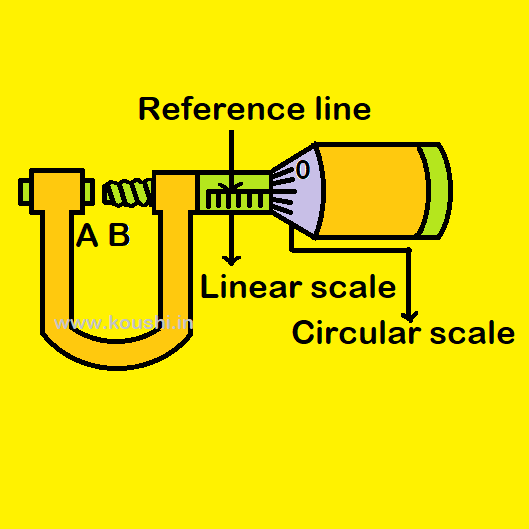
Calculation of diameter: Calculation for the screw gauge with each linear scale division 1mm and total circular divisions 100.
Pitch of the screw = ![]() = 1mm
= 1mm
Least count of the screw L.C.= ![]() = 0.01mm.
= 0.01mm.
When a rod is inserted in between two screw A and B then the readings of linear scale and circular scale are m and n divisions respectively. Then the reading of diameter = (m + n ![]() L.C.) mm.
L.C.) mm.
Zero error: When the faces of screw A and B are touched, if zero of circular scale is right side of the reference line then the zero error is positive. The value of positive zero error is subtracted from the total reading.
If zero of circular scale is left side of the reference line then the zero error is negative. The value of negative zero error is added with the total reading.
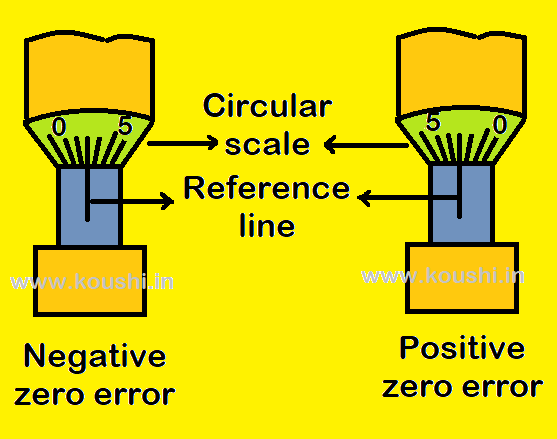
Click the button to go to the previous part of this chapter.
Click the button to go to the next part of this chapter.
